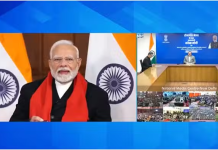Bengaluru, September 7: In a huge disappointment, communications from Chandrayaan-2’s Vikram lander to ISRO’s ground station here was lost before touchdown while the nation eagerly awaited its soft landing on the hitherto unexplored lunar south pole in the early hours of Saturday.
Addressing the scientists after the link was snapped, Prime Minister Narendra Modi said: “Nation is proud of you, be courageous.”
As the powered descent of the lander began at around 1.38 am, scientists at ISRO Telemetry Tracking and Command Network (ISTRAC) here were glued to their terminals, anticipating the soft landing.
They clapped and cheered as the moon lander completed the rough braking phase before the fine braking phase started.
It was then that the scientists started becoming tense and went into a huddle. ISRO Chairman K Sivan was seen engaged in intense discussions with some scientists.
Soon he announced that the Vikram lander descent was as planned and normal performance observed upto altitude of 2.1 km.
Subsequently communications from lander to ground station was lost, he said, adding the data was being analysed The Prime Minister said “Theyve (scientists) given their best and have always made India proud.” Modi also interacted with students and answered questions.
The 1,471-kg ‘Vikram’, named after Dr Vikram A Sarabhai, father of the Indian space programme, is designed to execute a soft-landing on the lunar surface, and to function for one lunar day, which is equivalent to about 14 earth days.
Chandrayaan-2’s 27-kg robotic vehicle ‘Pragyan’, which translates to ‘wisdom’ in Sanskrit, can travel up to 500 metres from the landing spot on the Moon and leverages solar energy for its functioning. Chandrayaan-2, a follow-on mission to the Chandrayaan-1 venture launched more than a decade ago, comprises an orbiter, lander (Vikram) and rover (Pragyan).
Sivan recently said the proposed soft-landing was going to be a “terrifying” moment as the ISRO has not done it before.
The Chandrayaan-2 is a Rs 978 crore unmanned moon mission (satellite cost Rs 603 crore, GSLV MK-III cost Rs 375 crore).
India’s Geosynchronous Satellite Launch Vehicle, GSLV MkIII-M1 successfully launched the 3,840-kg Chandrayaan-2 spacecraft into Earth’s orbit on July 22.
The spacecraft began its journey towards the moon leaving the earth’s orbit in the dark hours on August 14, after a crucial manoeuvre called Trans Lunar Insertion that was carried out by ISRO to place the spacecraft on “Lunar Transfer Trajectory.”
The spacecraft successfully entered the lunar orbit on August 20 by performing Lunar Orbit Insertion (LOI) manoeuvre.
On September 2, ‘Vikram’ successfully separated from the orbiter, following which two de-orbiting manoeuvres were performed to bring the lander closer to the Moon.
The health of the spacecraft is being continuously monitored from the Mission Operations Complex at ISTRAC here with support from Indian Deep Space Network (IDSN) antennas at Bylalu, near Bengaluru.
The orbiter carries eight scientific payloads for mapping the lunar surface and study the exosphere (outer atmosphere) of the Moon, according to ISRO officials. PTI
Chandrayaan-2
- July 22 The 3,840-kg Chandrayaan-2 spacecraft put into Earth’s orbit
- Aug 14 Space vehicle leaves Earth’s orbit for Moon
- Aug 20 Spacecraft enters lunar orbit
- Sept 2 Vikram lander separates from orbiter
- Sept 7 Contact lost with Vikram lander
The cost
- Chandrayaan-2: Rs 978 cr
- Satellite: Rs 603 cr
- GSLV MK III: Rs 375 cr
Terrifying 15 minutes
Vikram lander performs a series of braking manoeuvres over 15 mins while trying to soft-land in south polar region between craters Manzinus C and Simpelius N
Pragyan Rover
No link established with the lander in the last phase
Timeline
- 2.18 am ISRO confirms contact with Vikram lost
- 2.03 am ISRO chief briefs PM Modi
- 2.01 am Delay in landing
- 1.52 am Vikram lander completes rough braking phase, fine braking starts
The Orbiter
- Started circling in lunar orbit on Aug 20, has mission life of one year.
- Can communicate with Indian Deep Space Network at Bengaluru & Vikram lander
Why South Pole was significant
The surface area remains in shadow. There is a possibility of presence of water in permanently shadowed areas around it. The region has craters that are cold traps and contain a fossil record of early solar system.
Previous mission
- This was a sequel to 2008 Chandrayaan-1 mission
- Oct 22, 2008 Chandrayaan-1 takes off from Sriharikota
- Nov 14, 2008 Moon probe ejects, crashes near lunar south pole — confirms presence of water













































